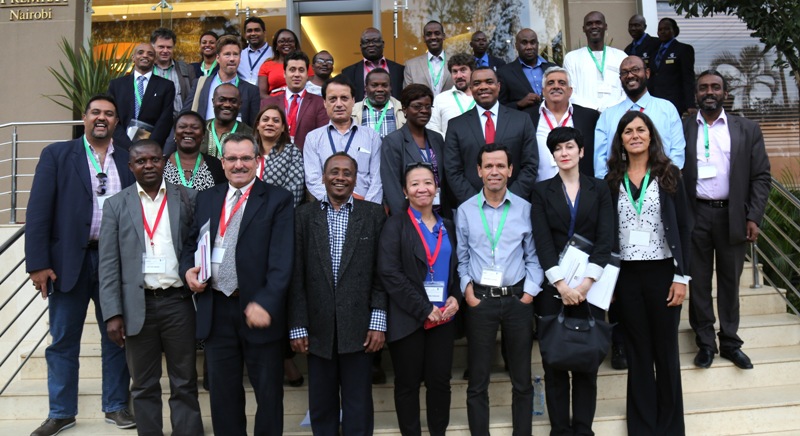As violent attacks on journalists surge to an unprecedented level with at least 55 confirmed dead in connection with their job so far this year according to the International Press Institute (IPI)’s Death Watch, 2015 may end up as one of the deadliest years for journalists since the beginning of the new millennium, participants at an expert roundtable convened in Kenya to address journalists’ safety said today following its conclusion.
The one-day roundtable, organised by IPI in cooperation with the Africa Media Initiative (AMI) and Al Jazeera’s Center for Pubic Liberties and Human Rights, brought together some 30 media experts and leaders of relevant media and non-governmental organisations on Sept. 3 in Nairobi to examine the experiences of journalists and civil society groups in developing and implementing mechanisms to bring about greater protection for journalists.
The roundtable gathered representatives from across the Middle East, Africa and Asia to develop recommendations that will be brought before a second roundtable on Sept. 14 in London focusing on the experiences of similar participants based in Europe and the Americas.
Both roundtables were sponsored by Al Jazeera in advance of the 2015 World Media Summit set for Nov. 3 to 5 in Doha. The Summit will provide an opportunity to discuss a number of initiatives and best practices to protect journalists and ensure their safety while doing their job.
Dr. Hassan Elmogummer, a member of the presidium overseeing the Al Jazeera Summit, noted that its programme would include two main sessions related to this discussion, which are intended to build on the work of participants in the Nairobi and London roundtables.
He said that the roundtables were organised with the aim of developing a single declaration that would combine principles and standards on media freedom and journalists’ safety drawing on multiple sources, including international humanitarian and human rights law; resolutions of the U.N. Security Council and Human Rights Council; and reports by international treaty bodies, independent experts, and special rapporteurs and task forces.
Elmogummer also expressed hope that the initiative would create a single platform for dynamic and effective debate between state parties as holders of certain duties, journalists and media institutions as stakeholders, and non-governmental organizations as observers.
The killings of journalists – as well as their intimidation, arbitrary arrest and unjustified incarceration – represent a major obstacle to journalists’ and media organisations’ ability to report the truth, depriving them of the ability to work in a safe environment free from fear.
AMI Senior Adviser Roukaya Kasenally, welcoming participants to the Nairobi roundtable on behalf of AMI’s CEO, emphasised the organisation’s commitment to the safety of journalists by engaging directly with media leaders and editors in chief. The topic is featured prominently in one of AMI’s core projects: the ‘Leadership Guiding Principles for African Media Owners and Managers’, which so far has been endorsed by some 200 media leaders in 33 African countries.
IPI Executive Board Chair John Yearwood, world editor of the Miami Herald, noted IPI’s similar commitment in opening remarks, telling participants: “For 65 years, this has been part of the fundamental mission of IPI: to work on the protection and safety of journalists.”
The need for concerted efforts that engage different sectors of society, while seeking proper coordination between various initiatives aimed at the protection of journalists, repeatedly came up during the roundtable discussion as a key element for the success of any long-term process.
Sami Alhaj, manager of Al Jazeera’s Center for Pubic Liberties and Human Rights and a member of IPI’s Executive Board, noted the importance of solidarity among media organisations and press freedom groups in exposing attacks against journalists and calling for a halt to them.
Alhaj’s call for solidarity was echoed by other roundtable participants, who particularly recalled how a joint boycott by the news media on covering threats issued by the Taliban in Afghanistan has been an effective strategy in fighting those threats.
Introducing a session about the value of an international declaration on journalists safety, IPI Executive Board Member and World Press Freedom Hero Daoud Kuttab, who is also director general of Community Media Network in Jordan, pointed out that “safety and protection of journalists are not brought about by training alone, nor by laws alone, but by a collection of numerous elements”.
He continued: “We are looking at three groups of stakeholders: journalists, who should be aware that no story is worth their lives; media organisations, which should never send journalists on assignments if they are not entirely sure they are prepared for them; and state institutions, which should end impunity in crimes against journalists.”
Participants in the roundtable also pointed out that a number of attacks on journalists are a direct consequence of a lack of public support for the profession, often brought about by inflammatory criticism of journalists by public figures.
In addition to some notable results achieved in the promotion of safety in Afghanistan, Pakistan and the Philippines, participants observed that the Kenyan experience – which saw civil society groups and media organisations working jointly with a statutory, but independent, media council to create safety mechanisms – appeared particularly successful.
Participants also said the possibility to learn lessons, and to replicate and adapt processes to different realities in which journalists are at risk, appeared particularly meaningful in the context of a south-south exchange.
*This statement was revised on Sept. 8, 2015.
